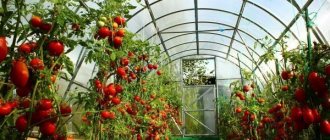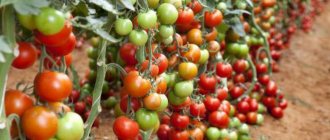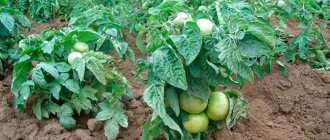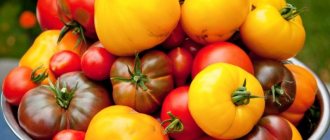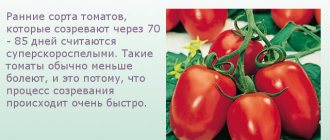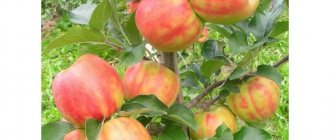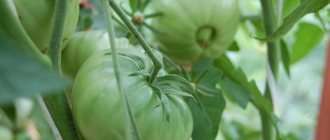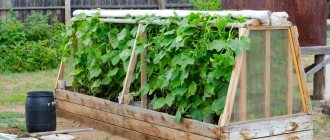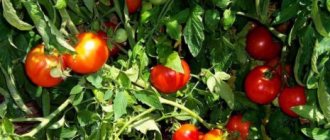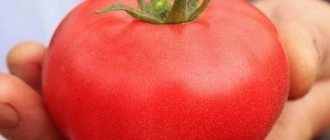Quite a few
varieties of tomatoes that are resistant to late blight for greenhouses In our article, we tried to offer the best of them and gave them characteristics; we also provide a detailed description of late blight, methods of combating it, and consider the factors that provoke the disease,
Tomato plague, the most terrible disease of tomatoes - these are the names summer residents gave to late blight. This disease can lead to the death of nightshade crops. late blight throughout the entire period of tomato cultivation . For decades, vegetable growers have been inventing various methods to destroy the causative agent of tomato disease.
This has led to the emergence of various methods in the fight against late blight. There are conventional means, such as the use of drugs, and exotic ones, which include the use of copper wire for the roots of tomatoes, as well as sprinkling the plants with fresh milk.
Tomato varieties resistant to late blight for greenhouses
Today there are no types of tomatoes that are completely protected from late blight and are never affected by this disease. They are also affected by late blight, but tolerate it much more easily, since they are highly resistant to fungal infections.
Tomato varieties for greenhouses resistant to late blight:
- Lark is a determinate variety, the height of which does not exceed 80-90 cm. Ripening time is up to 75-85 days. The fruits are large, weighing 110-130 g. The pulp is sweet, juicy, without sourness. The variety has good shelf life during storage and transportation.
- Cardinal is one of the most popular varieties for greenhouses. Tall bushes, up to 170-200 cm, require mandatory shaping and gartering. The fruits are large, dark red in color, and ripen alternately throughout the season.
- Oak is an early ripening variety grown in greenhouses. Ripening time does not exceed 85-95 days. Bushes up to 65-75 cm high, fruit weight does not exceed 80 g.
- Gypsies are low-growing plants with a height of 70-80 cm, in some cases reaching 100 cm. Ripening time is 105-110 days. The advantage of this variety is excellent seed germination and high yield. The fruits are large, up to 160 g, of an unusual red-brown color.
- Carlson - compact and neat plants in a greenhouse can reach 180-200 cm. Ripening time does not exceed 85-90 days. Carlson pleases summer residents with tasty and large fruits weighing 180-220 g. The yield of the variety reaches 8-10 kg per bush.
- Parsley gardener - refers to semi-determinate early ripening varieties. The height of the bushes is 170-200 cm. The first harvest can be harvested 95-105 days after the appearance of seedlings. The fruits weigh 330-370 g. With proper agricultural technology, you can get up to 8 kg of harvest from each bush.
Tomato varieties resistant to late blight also include Resonance. Bushes with a height of 110-135 cm delight with tasty and sweet fruits within 90-95 days from the moment of planting the seedlings. Resonance is often grown for sale, as its large fruits weighing 250-330 g attract attention with their symmetrical round shape, rich scarlet color, elasticity and excellent keeping quality.
How dangerous is late blight for tomatoes and what causes it?
Phytophthora is the name of a disease characteristic of the nightshade family, which is caused by a fungus.
Reference! The manifestation of the disease is watery spots covering the leaves of tomatoes. Then they begin to darken and soon become brown.
The spread of the fungus is observed on all parts of the plant; after the leaves, the stems and later the tomato fruits become infected. Late blight on a tomato is represented by a compaction under the skin of the fruit, darkening and increasing in size. As a result, the tomato is completely or almost completely deformed, its pulp becomes a brown substance with an unpleasant putrefactive odor.
Attention! Diagnosis of late blight in tomatoes is carried out by careful examination of the leaf, the underside of which, when infected, contains traces of a pale gray powdery coating. This plaque is formed by spores belonging to harmful fungi.
Important! Late blight is dangerous because its fungal spores are exceptionally resilient and spread very quickly. The death of a grower's entire crop can occur within just a few weeks. It happens that there is no way to overcome this disease.
A favorable environment for storing and propagating spores is formed in the soil. Late blight is not afraid of either extreme heat or low winter temperatures. It is extremely difficult to restore soil contaminated with spores that pose a threat to all crops belonging to the nightshade family.
Advice! It is very important to avoid planting tomatoes in a place where potatoes were previously grown.
Tomato beds should not be placed next to potatoes, as this vegetable can spread late blight very quickly.
Awakening of spores dormant in the soil occurs under the following conditions:
- at low air temperatures in summer;
- in case of insufficient illumination of the area, which is also facilitated by prolonged cloudy weather;
- at high humidity, which is an excellent environment in which microorganisms multiply quickly;
- with excessive watering;
- with excessive fertilizing with nitrogen fertilizers;
- with a lack of oxygen, poor aeration of plants;
- with a lack of potassium, iodine and manganese in the soil;
- when weeds grow among tomato bushes;
Advice! For the best results when fighting late blight, you should first of all eliminate the conditions that help the fungal disease develop.
Phytophthora-resistant varieties for open ground
When growing in open ground, it is best to use hybrids of domestic or foreign selection with strong immunity and high resistance to late blight and other fungal diseases.
Tomatoes resistant to late blight for open ground:
- Anyuta F1 is one of the most popular early ripening hybrids with high resistance to fungal diseases and adverse weather conditions. Compact and small bushes are characterized by fast growth and good fruiting.
- Alpatieva 905 A - a low-growing plant with a height of no more than 50 cm pleases with the first harvest already 105-115 days after germination of the seedlings. The fruits are small, up to 70-100 g, excellent for canning.
- Gnome is a universal low-growing variety with a ripening period of 90-105 days. Miniature bushes have a height of 40-60 cm. The fruits are small, weighing 50-80 g, regular round shape and rich scarlet color.
- Lark F1 - refers to early ripening hybrids with a ripening period of no more than 85-90 days. The hybrid tolerates all fungal diseases and frosts well. The fruits are sweetish and tasty, and have good keeping quality.
- Academician Sakharov - suitable for growing both in garden beds and in greenhouse conditions. Fruiting period does not exceed 85-95 days. The fruits ripen together, and the weight of one vegetable can reach 400-500 g.
Among the varieties of tomatoes resistant to late blight, one can highlight the indeterminate species Tatyana. It has an average ripening period - up to 95-105 days from the date of emergence. Each cluster consists of 6-9 fruits weighing 350-450 g. Tatyana is a high-yielding hybrid, producing 8-9 kg of fruits from each bush.
Early ripening with the strongest immunity
Tatiana
Indeterminate hybrid. The fruits ripen together - 6-7 pieces at once with the whole cluster. The berries are red and have a slightly flattened shape. The fruits are relatively small, weigh 70-80 grams, and have universal use. The hybrid is very productive - you can harvest a record eight kilograms from one plant!
Cardinal
The bush is tall, reaches 2-2.2 meters. In the greenhouse they plant one stem; in rare cases, one shoot is kept. The harvest ripens in just 80-83 days. They are characterized by large fruit: tomatoes weigh about 700-750 grams, and 30-35 kilograms are harvested per square meter. The fruits are red, fleshy, well stored and transported, and are most often consumed fresh.
Black
Otherwise called De Barao Black. The bush can grow up to two meters. Belongs to the group of hybrids. A characteristic feature is the purple hue of the berries. The fruits are characterized by thin and delicate, but elastic skin. The shape of the tomato is round, one piece weighs about 80-150 grams. You can collect up to 25 kilograms from one meter of bed.
Carlson
The variety is resistant to many fungi. Ripens in 80 days, the fruits are round, pink, and can grow in a cluster. If you take good care of the bush (tying it up and pinching it), you can get a harvest of 10-11 kilograms from a single plant. Each berry weighs 180-200 grams and is universal in use.
De Barao
Large blight-resistant group. Consider the orange subspecies De Barao. The hybrid is classified as indeterminate and does not exceed 2.0-2.1 meters in height. It has unlimited growth, so up to ten clusters of 5-6 fruits on each can appear on the bush. Tomatoes have good keeping quality. Characterized by a bright orange hue and slightly elongated shape. The fruits are universal in use.
Early blight-resistant tomato varieties
Early-ripening late blight-resistant tomato varieties are the best option for growing both in open ground and in greenhouses. They ripen before the spread of the disease and are distinguished by good taste and keeping quality.
Early varieties resistant to late blight:
- Golden Canary;
- Green honey;
- Grandmother's gift;
- Indira;
- Galant;
- Buvena.
Phytophthora-resistant varieties with ultra-early ripening include Antyufey F1. This is a hybrid with early ripening and high yield, reaching 15-17 kg per square meter. m. Scarlet fruits of a neat, round shape weigh 240-280 g.
Pests, diseases and methods of controlling them
Pests
Tomatoes are distinguished by good health, however, they are also susceptible to a number of diseases and pest attacks.
The most common pests and methods of controlling them:
- Slugs. To make them disappear, you should regularly loosen the soil near the stem and sprinkle with ground hot pepper (one teaspoon is enough per square meter of soil).
- Whitefly is a small midge with light, almost transparent wings. Use Confidor or its analogues.
- Spider mite. Barely visible to the naked eye, it resembles a small white dot. You can cure the bushes by spraying them with a soap solution, infusion of garlic and dandelion leaves, or treat them with Karbofos.
- Aphid. Small light green insects. In some cases, you can simply wash off the adults with a strong stream of water from a hose. Insecticides must be used to control eggs and larvae.
- Medvedka. A large (3-4 centimeters) insect that resembles a grasshopper without wings can be kept in the ground and eat roots. It has powerful burrowing legs and an elongated, full abdomen. To combat, gardeners use an infusion of hot pepper, a vinegar solution or chemicals, for example, “Thunder”.
- Wireworm is a yellowish-brown larva of a click beetle, reaching two centimeters in length. It is useful to reduce soil acidity. Wireworms are removed by liming the soil and preparations such as Bazudin.
- Gnawing cutworms are butterfly caterpillars. The color is gray, maybe almost black. The body does not exceed three to four centimeters in length. Pests are collected by hand, the beds are weeded, and the egg layings are poisoned with the drug “Strela.”
If proper agricultural practices are followed, the risk of pests and parasites is reduced significantly.
Diseases
Breeders have developed many varieties. Resistant to certain diseases, such as late blight or black rot. However, the risk of occurrence cannot be eliminated one hundred percent. Therefore, you should familiarize yourself with the main diseases of tomatoes in order to know what to deal with.
The most common ailments:
- Late blight. Characteristic signs are brown and brown spots on all above-ground parts of the plant. It is necessary to treat with the drugs “Zaslon”, “Barrier” and “Oxyx”. Sometimes an infusion of garlic is used.
- Blackleg. The stem at the base of the plant turns black and dries out, causing the plant to die. The disease cannot be treated; it often affects seedlings. To prevent the disease, use a solution of potassium permanganate (1-1.5 grams diluted in 10 liters of water).
- Cracking. The reason is excessive watering after a drought. Therefore, it is very important to maintain a stable watering regime.
- Dry spotting (Alternaria blight). At the beginning of development, the symptoms are very similar to late blight. Then dimples and indentations appear on the tomatoes, they have an oval shape on the stems, and round on the fruits. Infected and diseased bushes are sprayed with Antrakol, Consento, and Tattu.
Soil treatment and proper crop care are very important in disease prevention.
Medium and late varieties of late blight-resistant tomatoes
Tomato varieties with medium or late ripening periods can be short or tall, grown in open soil or in greenhouses. The only thing these varieties have in common is their high immunity to late blight and other fungal diseases.
Which tomatoes are not afraid of late blight?:
- Besuto;
- Barguzin;
- Dukoveri;
- Caspar striped;
- Fig raspberry.
Popular hybrids with late ripening include the Volgograd motives variety. It is distinguished by consistently high yields - up to 8-10 kg per 1 sq. m. The fruits are flat-round, bright scarlet in color, weighing 280-330 g.
Tomato varieties resistant to late blight are popular among summer residents and vegetable growers who grow them in garden beds and greenhouse conditions. Such varieties and hybrids are highly resistant not only to late blight, but also to many other fungal infections. At the same time, blight-resistant tomatoes invariably delight with their ease of care, high yield and excellent taste of the fruit.
Domestic low-growing hybrids
Dwarf
The bushes are compact and very miniature - 40-45 centimeters in height. The fruits are small, round and orange-red in color. Very small - weighing only 40-45 grams. From a bush you can collect 3-3.5 kilograms. Berries are universal in use.
Dubrava
Ultra-early variety - the harvest fully ripens in 75-80 days. The fruits are small (50-60 grams). The color is bright red, at the stalk it can turn pinkish. The yield is high for a low-growing determinant - 4-4.5 kilos. "Dubrava" does not need gartering or pinching.
Orange miracle
The variety is unpretentious, resistant to drought and rare rains. The fruits ripen in clusters of 7-8 pieces, each tomato weighs 300-350 grams. The skin is very thin and delicate. Color can vary from dull orange to scarlet, thin longitudinal yellow stripes are acceptable. Characterized by long fruiting, starting in June.
Perseus
A universal variety, grows up to 65-70 centimeters. Perseus is immune to most fungi and bacteria; it is rarely parasitized by the Colorado potato beetle and wireworm. The fruits are perfectly round, deep red, there are 5-6 pieces in a bunch, 55-70 g each, the skin is dense. This variety of tomato has a universal use in cooking, but more often it is used to prepare casseroles, pizza and other hot dishes.
Late blight - what is it?
Late blight of tomatoes - photo The disease described in the article is caused by the fungi Phytophthora infestans. Initially, the rot affects the leaves, but soon reaches the fruits themselves. One of the characteristic signs is dark spots that spread throughout the entire bush in just a few days. Tomatoes affected by photoblight The first manifestations of late blight can be observed by the end of summer.
Latest articles for gardeners, gardeners and flower growers
Pruning cherries in the fall for beginners in pictures step by step
What to plant after tomatoes next year
What to plant after strawberries in the fall
Planting garlic in autumn before winter in Siberia
But if the temperature is more than +15°C, and the weather is quite humid, then the disease can manifest itself much earlier. On a note! Early-ripening and hybrid varieties of tomatoes, which manage to ripen even before the outbreak of the epidemic, are less susceptible to “brown rot” than others.
Tomatoes Karotinka
A mid-early variety, resistant to unfavorable growing conditions. Fruiting occurs 100-111 days after germination of the seed material. The variety is unpretentious and has a high, stable yield.
Determinate bush. Height 50-60 centimeters. The leaves are medium in size and green. The plant does not need pinching. Fruiting is abundant and long lasting. The yield per square meter is 4.5 kilograms of fruit.
The fruits are cylindrical. Weight is 50-70 grams. The taste is good. The skin is orange, medium density, smooth. The number of cameras is 2-3 pieces.
The variety is universal in purpose. Tomatoes are good raw and prepared.
Selection of varieties for different climatic zones
The quality of the crop also depends on the growing region. The more fertile the soil and the warmer the climate, the higher the likelihood of getting a lot of tasty and ripe tomatoes. The tomatoes listed below are best grown in polycarbonate greenhouses, especially in central Russia.
Growing tomatoes in Siberia
The following tomatoes are best suited for Siberian lands:
- Siberian early ripening;
- Altai seeds;
- Siberian Garden;
- Demidov;
- Ultra early ripening.
What tomatoes to grow in the Urals
Gardeners in the Urals should pay attention to the following varieties:
- Raisin;
- Skorokhod;
- Lollipop;
- Titanic;
- Wonderful lady.
Choice for greenhouses in the Moscow region
Compared to the Urals and Siberia, the Moscow region has better climatic conditions for growing tomatoes. The following varieties are recognized as leaders:
- Alenka;
- Ox heart;
- Nectar;
- De Barao;
- Mongolian dwarf.
Varieties that are not afraid of late blight for Belarus
Not all tomatoes with resistance to late blight grow well in Belarus due to the climate. However, there are several varieties that are suitable for this country:
- Evgenia. Belarusian farmers prefer to grow Eugenia, since its bushes are rarely infected with fungal diseases. The variety is also distinguished by high-quality fruits that do not crack after picking and are suitable for pickling.
- Aurora. Gardeners recommend planting Aurora if tomatoes are needed for preparing fresh salads. The taste of ripe tomatoes will make any vegetable dish much tastier. It is better to plant Aurora in greenhouses, where the temperature will remain above zero.
- Admiral. Indeterminate tall plant with bushes 2-3 meters high. The Admiral's harvest is stored for a long time and can be transported over long distances without problems.
Reinsurance is the key to success
When preparing to sow seeds of any tomato variety, it is better to play it safe and adopt standard methods for sanitizing seeds. For this use:
- Potassium permanganate.
- Baktofit.
- Bordeaux mixture.
Treating tomato seeds with a 1% potassium permanganate solution will protect tomato seeds from diseases. To do this, tomato seeds are wrapped in gauze and placed in a bowl with an already diluted purple preparation.
Experts recommend using the fungicide Baktofit when transplanting young seedlings into open ground. To do this, the drug is applied with watering at the root.
A 1% solution of Bordeaux mixture also fights putrefactive fungus well. After tomato ovaries appear on the bushes, they are sprayed with the preparation for 10–12 days until the berries are filled with red juice. Treatment is stopped 10 days before harvest.
Copper oxychloride solution copes well with the attacks of late blight. For 1 bucket they usually take 40 grams of the substance. After preparing the mixture, spray the tomato bushes with it. The procedure is stopped 20 days before picking ripe berries.
Proven ways to avoid getting infected
Proper watering will protect tomato beds from late blight. Water should be poured at the root of the plant, and not on its foliage and stem. To avoid the appearance of rot, a plastic bottle of water, with holes previously made in the walls, is buried next to the young seedling when planting. This way, the plant drinks without being exposed to excess moisture.
There are also old-fashioned methods of combating brown rot fungus. Tomato bushes used to be treated with cow's milk, iodine or mustard. Some experts are still confident that if you pierce a bush at the base with copper wire, then late blight is not dangerous. Few “old believers” still wrap the roots of young tomato seedlings with a coil of copper wire.
Every day scientists make new discoveries in various fields of science. Perhaps soon varieties of tomatoes that are completely resistant to all known diseases of these plants will appear on the shelves of garden stores.
Varieties for Ukraine
Ukrainian farmers, when growing tomatoes, often encounter a vegetable disease such as late blight. To prevent tomato bushes from getting sick, it is necessary to grow blight-resistant varieties that will grow well in Ukraine. These include:
- Mobile Farmers from Ukraine often plant Mobile, as it bears fruit well in many areas of the country. If grown correctly, the yield will reach 10 kilograms per bush.
- Pink cheeks. This is a heat-loving plant that is best grown in the southern regions of Ukraine. Ripe fruits weigh 300-350 grams.
Description and development process of late blight
Brown rot (late blight, late blight) affects all plants from the Solanaceae family, but tomatoes and potatoes are especially susceptible to infection.
The nature of the disease is fungal (scientists have identified more than 100 varieties of pathogenic microorganisms). Late blight is spread by spores. High humidity and air temperature, not higher than +22 degrees, contribute to widespread plant disease.
The sooner a gardener recognizes an infection, the easier it is to cure the plant. Late blight on tomatoes manifests itself as follows:
- dark spots with a yellow edge appear on the underside of the leaf blade;
- brown spots on the stems quickly become covered with a whitish coating;
- on fruits, spots first appear near the stalk (this is the main difference between late blight and blossom end rot).
Bush with tomatoes in the garden
As the disease develops, the tomato greens turn yellow and dry out, the stem rots, and the fruits become soft. Sick plants serve as a source of infection for neighboring bushes.
Important! Fungal spores can easily be transferred on shoes, hands, and tools from diseased bushes to healthy ones. Infection can also occur through seed or soil.
Perseus tomatoes
Determinate early-ripening crop, the height of the bushes reaches 70 centimeters. The fruits ripen after 117 days. Their color is red, weight is about 130 grams. Transportation is well tolerated, and the original qualities are preserved.
Tomatoes Little Prince
An early ripening tomato variety that ripens 90-95 days after planting. Tomatoes, as the name suggests, are small, 40-45 g, round in shape. The fruits are considered universal and are great for eating raw and for canning. The variety is characterized by a stable harvest that ripens at the same time, and excellent taste.
Reviews from experienced farmers
What are the most productive tomatoes you should pay attention to? Among the positive properties, experienced farmers note the excellent taste of the Tatyana, Little Prince, and Cardinal varieties.
In addition, the varieties Volgogradsky, Babushkin Secret and Nagrada should be noted - many speak positively about these tomatoes, value them for their easy care and unique taste.
Reference. On online forums you can always read reviews from summer residents and gardeners - this is useful before you start planting this or that variety of tomatoes in your garden.
Peter from Magnitogorsk: “I’ve been planting the Cardinal variety on my plot for several years now, and I’m very pleased with the result. I am pleased that these tomatoes have excellent immunity to late blight.”
Anna: “We were dissatisfied with the Far North and Dubok varieties - these varieties have insufficient resistance to fungal diseases.”
Japanese creeping
A very miniature plant rarely grows above 30 cm. The shoots spread along the ground, so it is fundamentally important to adhere to the seating plan. A pleasant advantage is that the fruit-bearing bed also looks very nice.
Photo: vosadu-li-vogorode.ru
20 Best Heat and Drought Tolerant Tomato Varieties
Reasons for the development of the disease
Tomato varieties resistant to late blight are being improved every year. Previously, they were represented only by early-ripening varieties, because a surge in the disease is observed in the second half of summer. During this period, heavy precipitation begins and frequent temperature changes. All this makes a favorable environment for the development of late blight fungus spores. The fungus does not tolerate sunlight, but in shady areas with high humidity it feels at ease and begins to develop quickly. The biggest problem is that the fungus can persist in the soil throughout the winter; it can withstand frost and begins to develop when the time is favorable.
Spores can remain not only in the soil, but also on seeds and unharvested plants. If it is possible to disinfect seeds and remove the remains of greenery, then it is impossible to get spores from the deep layers of the soil, so people began to select for planting low-growing varieties of early or medium ripeness that are not afraid of late blight. But there is one catch here: if early-ripening varieties are planted in order to get a harvest, and then sell it and sow new tomatoes, then the risk of late blight spreading to the second crop will be quite large.
Care
Selection does not stand still, and on the market today you can find many varieties that are practically not susceptible to fungal diseases. Still, it is worth selecting varieties depending on the climatic conditions of your region and following basic care rules.
For example, in the cool, important climate of the Moscow region, southern heat-loving plants should not be grown. If tomatoes are grown for sale, then in the climatic conditions of the Moscow region it is recommended to plant the vegetable in greenhouses: this makes it easier for the gardener to provide the necessary conditions and reduce the humidity in the greenhouse without any problems.
Tomatoes Cardinal
This is a mid-early hybrid variety. It is cold-resistant and easily tolerates temperature changes. From the formation of seedlings to harvesting, 99-120 days pass.
Determinate bush. Height 1.6-2 meters. It needs gartering, pinching and shaping into 1-2 stems. 5-7 fruits are formed on 1 brush. 4.5 kilograms of tomatoes are harvested from a bush per season (16 kilograms per square meter). Fruiting of the variety is extended.
Fruit weight is 200-600, sometimes 850 grams. The skin is raspberry-pink, dense, tough. The taste is sour-sweet. The pulp is juicy.
Universal use in tomatoes. The first fruits are not used for pickling in their entirety, as they are large in size. Shelf life is long. Transportability is easy.
